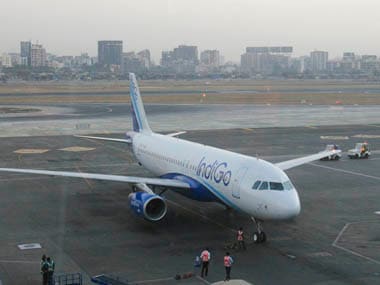For the first time since inception, IndiGo cornered over 30% share of the domestic market in September, inching closer to the one third mark as domestic traffic grew for the second consecutive month despite steep fare increases by most airlines.
September also marked emergence of Air India as clearly the second most chosen domestic airline - it was earlier neck and neck with SpiceJet most months.
The national airline crossed the 20% market share mark. So now, one in three domestic passengers travel IndiGo while every fifth flyer prefers AI flights. Jet Airways (standalone) was close to AI at 19.1% share of the market but SpiceJet remained at 17.3%.
[caption id=“attachment_1106069” align=“alignright” width=“380”]  One in three domestic passengers travel IndiGo. Reuters[/caption]
As per data released by aviation regulator DGCA today, traffic grew a healthy 13.4% in September over August with 45.55 lakh flyers against September’s 40.18 lakh. Only in the last few months has domestic traffic reversed its previous decline and actually begun to show some growth - September growth must have largely come from festive travel. But while overall traffic growth returned to healthy double digits, no domestic airline was able to fill more than 70% of seats on its planes and some did not manage to fill even this number.
The Jet Airways Group held the dubious distinction of flying its planes at least a third empty - Jet’s load factor was just 63.7% whereas for JetLite it was 63%. Load factor is the percentage of seats on a plane which are filled. Compared this to August when Jet was able to fill three in four seats at almost 75% load factor while JetLite was able to fill almost 74% of the seats on its flights and the decline in occupancy across the Jet group stands out sharply.
The other airlines where load factors declined sharply compared to August were SpiceJet and GoAir - from 75.8% to 67.9% for SpiceJet and from 79% to 67.5% for GoAir.
Impact Shorts
More ShortsAir India managed maximum occupancy among all domestic airlines, even beating market leader IndiGo. Air India filled 73.5% of its seats which is close to three in four seats but IndiGo managed only 70.3% load factor in September.
September was only the third consecutive month this calendar year when airlines deployed more capacity (which means offered more seats) in the domestic market as traffic growth returned. But what could be worrisome for airlines is the inability to fill at least 30% of seats even in the peak festival season and the impending competition from new entrants like AirAsia - this airline is expected to begin operations by the March quarter next year.
Already, though loads are abysmal, airlines are raking in the moolah by effecting a steep increase in both, spot fares and advance purchase fares. This is good for airline yields but may scare away more passengers in the continuing festival season and then the holiday traffic from November end. If market leader IndiGo is also flying with 30% seats empty, perhaps airlines need to once again rationalise capacities.


)

)
)
)
)
)
)
)
)



